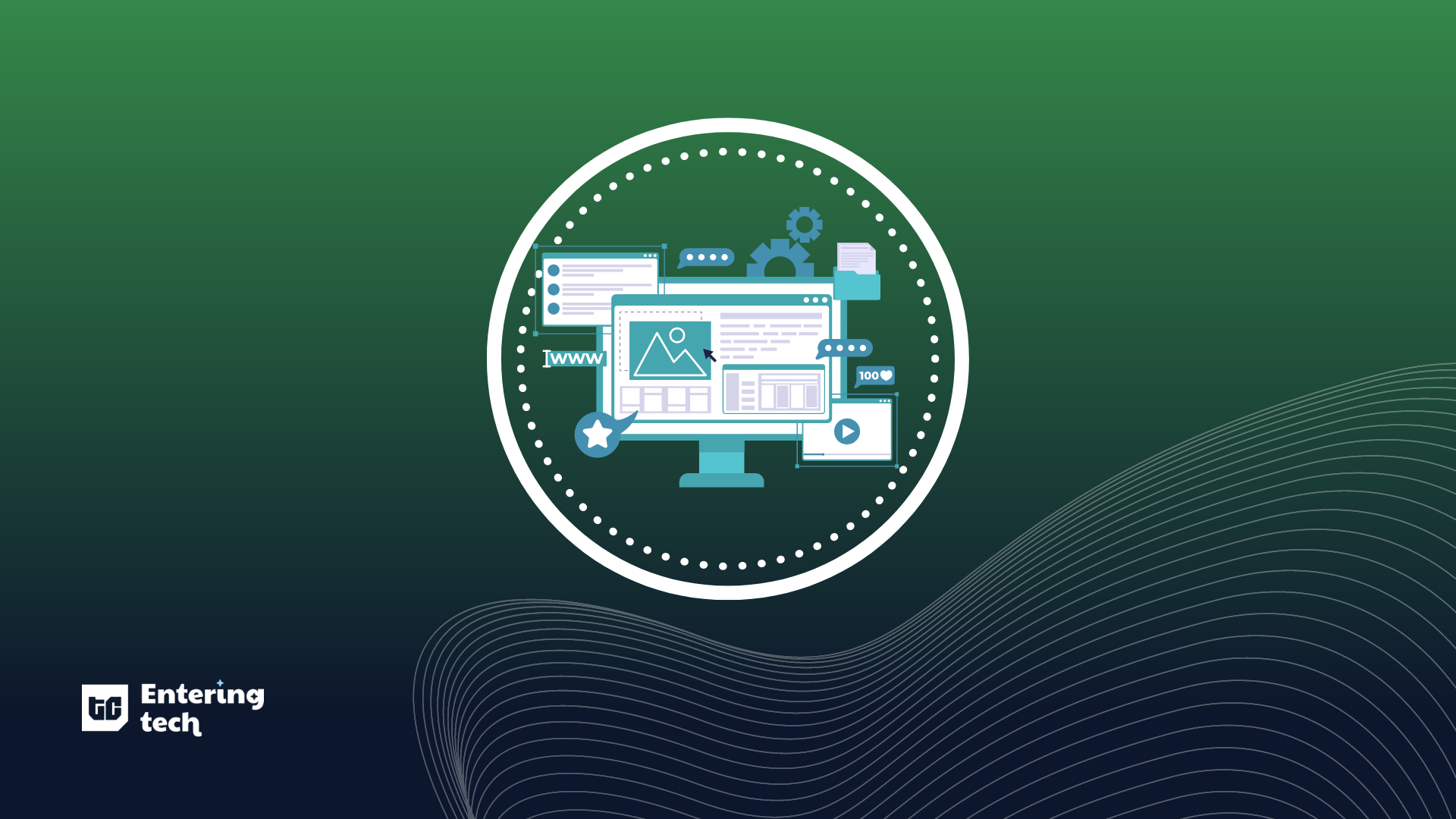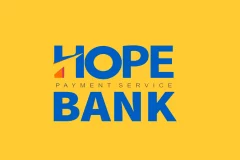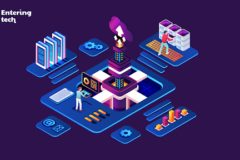
29 || 03 || 23
View in BrowserBrought to you by

#Issue 24
How to become afrontend engineer
Greetings ET Readers 🖖🏾
If you’ve ever been in awe of the magic that makes your favourite websites and apps look so good, this edition of #EnteringTech🚀 is for you. What makes those sites and apps look good isn’t actually magic, but it comes pretty close: frontend engineering!
In this edition, we take a close look at what frontend engineers do, what languages and tools they use, as well as tips for newbies considering entering the field.
If you love the visuals and aesthetics of things, and you’re always looking for ways to make them look good, you might want to consider a career in frontend engineering.
Happy reading, and don’t forget to share #EnteringTech🚀 with your friends and network!
by Pamela Tetteh & Timi Odueso.

Tech trivia
Some trivia before we begin. Answers are at the bottom of this newsletter.
- What is the most popular frontend programming language?
- How much, on average, do frontend engineers make in Africa?

What is frontend engineering?
In last week’s edition of #EnteringTech🚀, we spoke about software engineering as a whole.
There, we briefly broke down the four critical roles across the software engineering industry: frontend, backend, DevOps and Cloud engineering. These aren’t the only roles in software engineering, of course, but because we aren’t ChatGPT who apparently knows everything, let’s just stick to the basics.
In today’s edition, we’ll talk a little bit more about frontend engineering. As we mentioned, frontend engineering basically deals with the “front” aspect of a website or an app.
💡 Think about it this way. Your body has external and internal organs. Your skincare, pedicures and haircuts all make you look good and neat on the outside. That’s frontend! But the drugs you take, the food you eat, how you take care of your organs, that’s all internal. You can’t see it, but you know that your beating heart is the reason you spent all of Valentine’s Day crying. That’s backend.
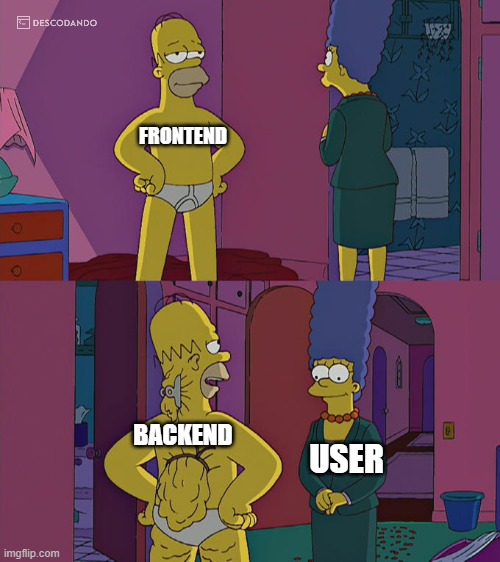
Frontend has to do with all the visual aspects of digital products.
💡 Here’s another quick example: When you visit Jumia and browse through the different products, you’re interacting with the work of a frontend engineer. But when you order a product, enter your address, and pay, you’re interacting with the work of a backend engineer.

How frontend engineering works
Frontend engineers develop the visual aspects—pages, menus, buttons, links, and graphics—that you see, use, and click.
If you can directly interact with it, it’s frontend.
They do this using programming languages like HTML, CSS, and JavaScript so it’s still coding. For example, this newsletter uses HTML—which makes me a tech bro if you think about it 😅.
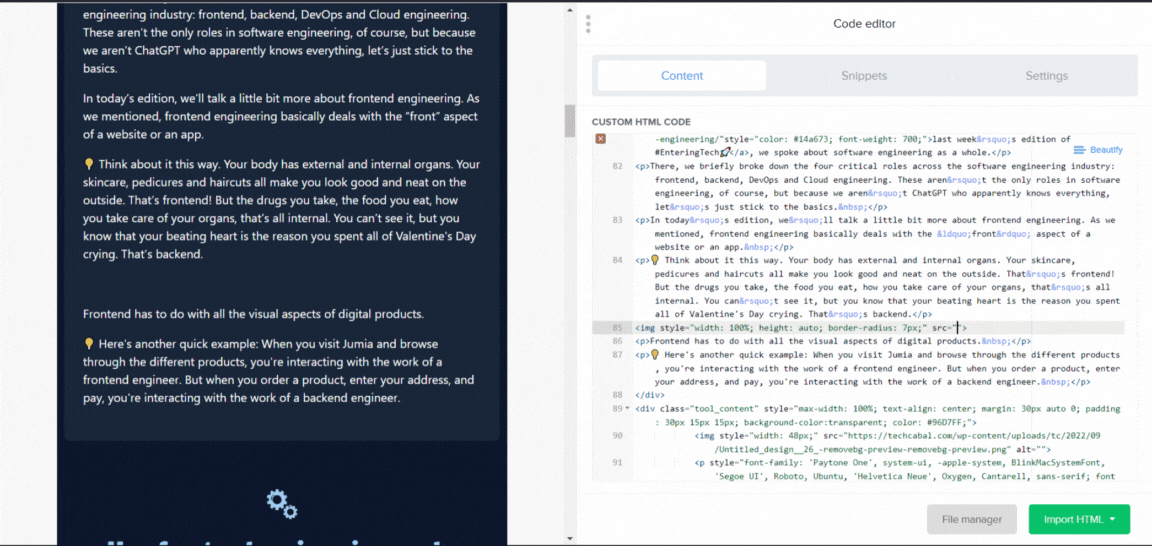
To become a frontend engineer, you’ll need to learn all three of the languages we listed above, as they’re the most critical—and don’t worry, it’s not as difficult as everyday languages. There are tags—basically the computer language for commands—that runs across all three like:
- H1–H6: <h1> which deals with headers. [insert image of h1 compared to h2 from newsletter.]
- Or <a> which deals with hyperlinking a text.
- Or even <em> which italicises a word.
Once you learn the different tags that call up buttons, bolden text, and make things move, you’ll be able to understand frontend engineering a bit better.

Tools of a frontend engineer
👨🏾💻 Hardware
To excel at frontend, you’ll need a laptop. We scoured the web and many frontend developers advise newbies to get laptops with:
- a Core i5 processor
- 8 GB RAM
- 256 GB SSD; and
- Screen resolution of 1366 X 768 pixels.
This should be the basest type of laptop that will give any newbie great performance for frontend. You don’t need a MacBook Pro just yet. You can check out the HP Notebook 15, for example, which costs $410 if you’re getting it new, and even less when you’re buying second-hand.
If you can’t afford a new or optimum laptop, however, use what you have and learn when you can. Everyone starts from somewhere 😉.
🖥️ Software
The basic tool for frontend development is a good code editor and there are many code editors out there.
There’s Sublime Text, Atom, Visual Code Studio and Chrome Developer Tools which are some of the most popular.
There are also several other resources like Envato HTML Templates which has thousands of website templates ready, and GitHub which boasts a vibrant developer community.
The more you learn about frontend, the more you’ll discover which tools you need, and which are just nice to have—like work-life balance.
My Startup in 60 Seconds

In this edition of My Startup in 60 Seconds, Babatunde Akin Moses, the founder of Sycamore, talks about how the P2P lending platform is committed to creating a more seamless lending process for users by connecting them directly with their peers.

You can learn frontend too
If you’re interested in becoming a frontend engineer, here are courses you can take.
- Price: $434
- Duration: 2 months
- Tools Needed: Internet + laptop
- Level: Beginner
- Price: $65
- Duration: 17 hours (on video)
- Tools Needed: Internet + laptop
- Level: Beginner
- Price: $290
- Duration: 9 months
- Tools Needed: Internet + laptop
- Level: Beginner (
*Presently closed to applications
- Price: $1,740
- Duration: 23 weeks
- Tools Needed: Internet + laptop
- Level: Beginner
- Price: Free (Pay for certificate)
- Duration: 33 hours
- Tools Needed: Internet + laptop
- Level: Beginner

Ask a techie
Q. I’ve worked as an operations manager for a logistics and transport company, and a sanitation company. I’m about to complete my MBA in General Management. What area in tech would you recommend that can make my skills valuable to organisations, and will yield sustainable returns?
Definitely project management. The thing about tech companies is that they need skills from everyday jobs. So tech companies like Flutterwave, Kuda Bank or Uber will need HR support to help them hire and retain the best talent, marketers to help them sell their market, and of course project managers to help them manage their many projects.
In tech, project managers are often called “technical project managers” and it is their job to coordinate projects across multiple teams and make sure everyone has the resources they need to meet the company’s timelines and goals. As a technical project manager, your job will be to pursue the vision of every project, eliminate roadblocks and manage people. Here’s more about technical project management.
No doubt, your skills working as an operations manager and your MBA will make you indispensable to any tech company.
Q. Who would you suggest I follow on YouTube on my way to becoming a frontend developer?
Go and follow TechCabal first. Please, we need subscribers 🙏🏽.
So we asked our audience on TechCabal’s Twitter and here are the best YouTubers to keep your eyes on if you want to learn frontend engineering.
- Learn with Jason has 90-minute clips which feature frontend engineers that teach the basics.
- There’s ColorCode which we highly recommend for its humourous and short clips on HTML, CSS, JavaScript and the rest.
- You should also check out Coder Coder which is another funny channel with practice tips and tricks for frontend engineering.
- Finally, we’d recommend Fun Fun Function which is a now-defunct channel that has really good explainers on the basics of frontend.
That’s all we can take this week. Have any questions about working in tech? Ask away and we’ll find answers for you.👇🏾

Tech trivia answer

Opportunities
- The Jasiri Talent Investor Programme is looking for highly driven individuals with a history of achievement and/or entrepreneurial action who aspire to launch a high-growth venture. Apply by April 23.
- The Growth Africa Accelerator Programme is calling for applications from ambitious and committed entrepreneurs from Kenya, Uganda, Ethiopia, Zambia or Ghana, with the potential to grow and create impact through their businesses. Apply now.
- The HiiL Justice Accelerator Programme is now open for applications from Kenyan startups with solutions that help people resolve their legal problems. Eight selected startups will receive $10,000 in equity-free funding as well as the chance to win up to $21,000 on Demo Day. Apply by March 31, 2023.
- ALX Africa is calling for young African learners who are interested in data analytics, data science, cloud computing, and salesforce administration to apply to its new world-class programmes at no cost to them. Apply to any ALX course here.
- The Africa’s Business Heroes (ABH) Prize Competition, a philanthropic initiative sponsored by the Jack Ma Foundation and Alibaba Philanthropy, is calling for participation from Africa’s entrepreneurial talent. Apply by May 12.

Jobs
- Lemonade Finance – Social Media Associate, Senior Backend Engineer, Security Engineer – Africa (Remote)
- Assets MFB – Head of Brands and Marketing – Nigeria
- Kuda Bank – DevOps Engineer, Backend Engineer, Android Engineer, Lead Product Manager, Copywriter, UX Writer, – Nigeria
- Andela – Engineering Matching Specialist – Remote
- Big Cabal Media – Software Developer, Senior Product Manager, Sales Associate, Senior Sales Manager – Lagos, Nigeria (Hybrid)
- Moniepoint – Frontend Engineer (Angular), Frontend Engineer (React), Senior Frontend Engineer (Angular), Senior Frontend Engineer (React), Technical Product Manager, Technical Product Specialist – Various Locations
Disclaimer: TechCabal is not affiliated with or associated with jobs and opportunities listed on all its job boards and newsletters. All applicants bear the responsibility of researching about the roles and companies they apply to.

No longer want to receive these emails? Unsubscribe here







